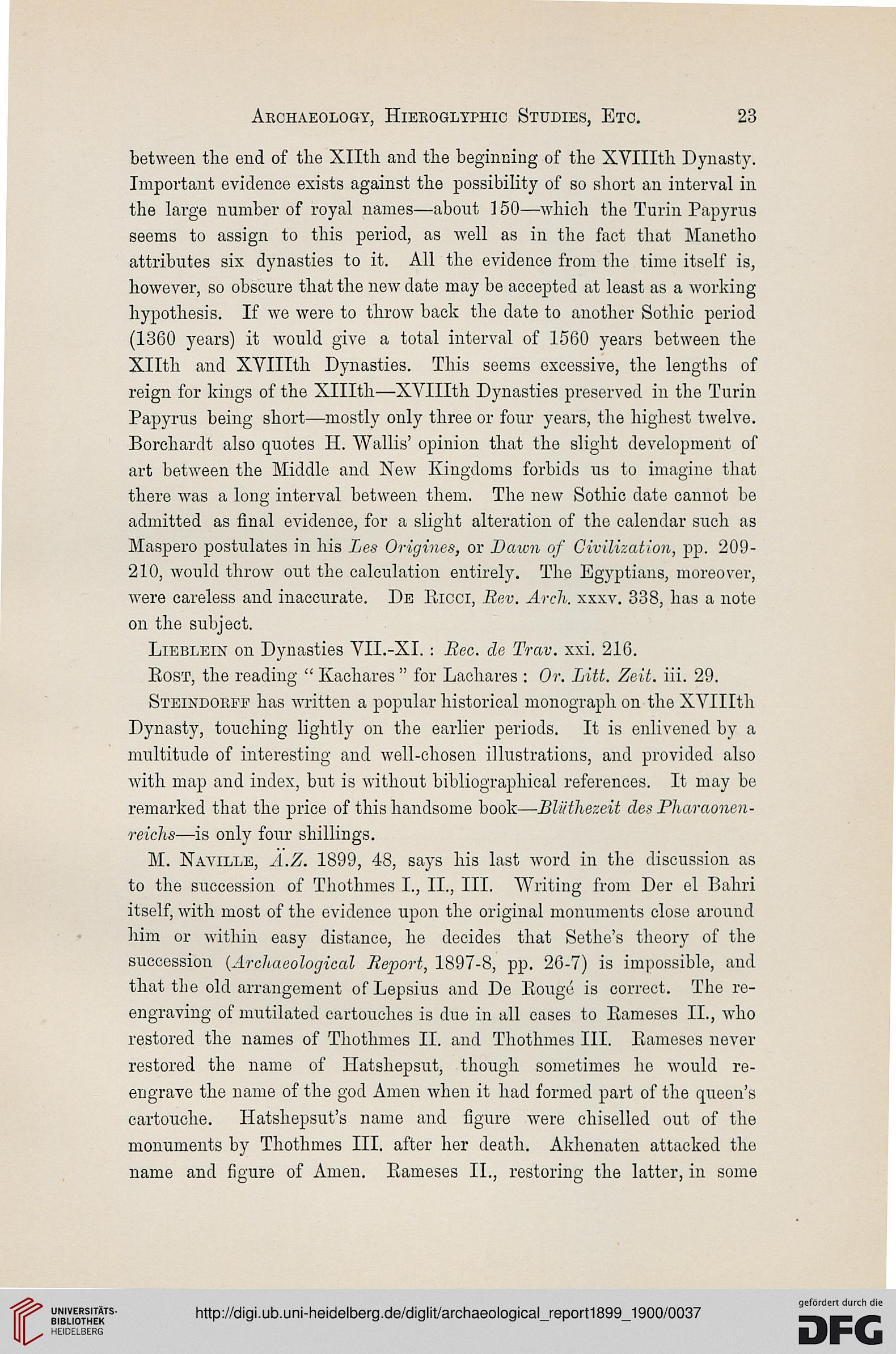Archaeology, Hieroglyphic Studies, Etc.
2:!
between the end of the Xllth and the beginning of the XVIIIth Dynasty.
Important evidence exists against the possibility of so short an interval in
the large number of royal names—about ] 50—which the Turin Papyrus
seems to assign to this period, as well as in the fact that Manetho
attributes six dynasties to it. All the evidence from the time itself is,
however, so obscure that the new date may be accepted at least as a working
hypothesis. If we were to throw back the date to another Sothic period
(1360 years) it would give a total interval of 1560 years between the
Xllth and XVIIIth Dynasties. This seems excessive, the lengths of
reign for kings of the Xlllth—XVIIIth Dynasties preserved in the Turin
Papyrus being short—mostly only three or four years, the highest twelve.
Borchardt also quotes H. Wallis' opinion that the slight development of
art between the Middle and New Kingdoms forbids us to imagine that
there was a long interval between them. The new Sothic date cannot be
admitted as final evidence, for a slight alteration of the calendar such as
Maspero postulates in his Les Origines, or Dawn of Civilization, pp. 209-
210, would throw out the calculation entirely. The Egyptians, moreover,
were careless and inaccurate. De Kicci, Rev. Arch. xxxv. 338, has a note
on the subject.
Lieblein on Dynasties VII.-XI. : Rec. de Trav. xxi. 216.
Eost, the reading " Kachares " for Lachares : Or. Lilt. Zeit. iii. 29.
Steindohff has written a popular historical monograph on the XVIIIth
Dynasty, touching lightly on the earlier periods. It is enlivened by a
multitude of interesting and well-chosen illustrations, and provided also
with map and index, but is without bibliographical references. It may be
remarked that the price of this handsome book—Bluthezeit des Pharaonen-
reichs—is only four shillings.
M. Naville, A.Z. 1899, 48, says his last word in the discussion as
to the succession of Thothmes I., II., III. Writing from Der el Bahri
itself, with most of the evidence upon the original monuments close around
him or within easy distance, he decides that Sethe's theory of the
succession {Archaeological Report, 1897-8, pp. 26-7) is impossible, and
that the old arrangement of Lepsius and De Bougu is correct. The re-
engraving of mutilated cartouches is due in all cases to Eameses II., who
restored the names of Thothmes II. and Thothmes III. Eameses never
restored the name of Hatshepsut, though sometimes he would re-
engrave the name of the god Amen when it had formed part of the queen's
cartouche. Hatshepsut's name and figure were chiselled out of the
monuments by Thothmes III. after her death. Akhenaten attacked the
name and figure of Amen. Eameses II., restoring the latter, in some
2:!
between the end of the Xllth and the beginning of the XVIIIth Dynasty.
Important evidence exists against the possibility of so short an interval in
the large number of royal names—about ] 50—which the Turin Papyrus
seems to assign to this period, as well as in the fact that Manetho
attributes six dynasties to it. All the evidence from the time itself is,
however, so obscure that the new date may be accepted at least as a working
hypothesis. If we were to throw back the date to another Sothic period
(1360 years) it would give a total interval of 1560 years between the
Xllth and XVIIIth Dynasties. This seems excessive, the lengths of
reign for kings of the Xlllth—XVIIIth Dynasties preserved in the Turin
Papyrus being short—mostly only three or four years, the highest twelve.
Borchardt also quotes H. Wallis' opinion that the slight development of
art between the Middle and New Kingdoms forbids us to imagine that
there was a long interval between them. The new Sothic date cannot be
admitted as final evidence, for a slight alteration of the calendar such as
Maspero postulates in his Les Origines, or Dawn of Civilization, pp. 209-
210, would throw out the calculation entirely. The Egyptians, moreover,
were careless and inaccurate. De Kicci, Rev. Arch. xxxv. 338, has a note
on the subject.
Lieblein on Dynasties VII.-XI. : Rec. de Trav. xxi. 216.
Eost, the reading " Kachares " for Lachares : Or. Lilt. Zeit. iii. 29.
Steindohff has written a popular historical monograph on the XVIIIth
Dynasty, touching lightly on the earlier periods. It is enlivened by a
multitude of interesting and well-chosen illustrations, and provided also
with map and index, but is without bibliographical references. It may be
remarked that the price of this handsome book—Bluthezeit des Pharaonen-
reichs—is only four shillings.
M. Naville, A.Z. 1899, 48, says his last word in the discussion as
to the succession of Thothmes I., II., III. Writing from Der el Bahri
itself, with most of the evidence upon the original monuments close around
him or within easy distance, he decides that Sethe's theory of the
succession {Archaeological Report, 1897-8, pp. 26-7) is impossible, and
that the old arrangement of Lepsius and De Bougu is correct. The re-
engraving of mutilated cartouches is due in all cases to Eameses II., who
restored the names of Thothmes II. and Thothmes III. Eameses never
restored the name of Hatshepsut, though sometimes he would re-
engrave the name of the god Amen when it had formed part of the queen's
cartouche. Hatshepsut's name and figure were chiselled out of the
monuments by Thothmes III. after her death. Akhenaten attacked the
name and figure of Amen. Eameses II., restoring the latter, in some





